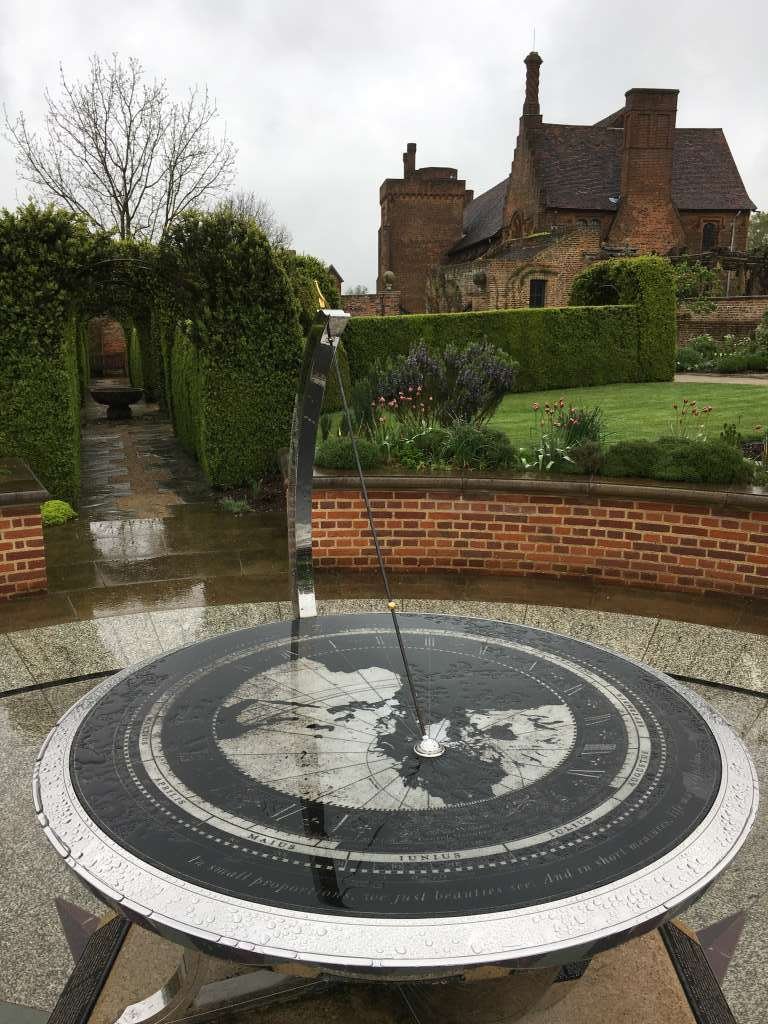
The Hatfield House Sundial - as seen in the wet!

The sundial at Hatfield House was installed in June 2011 in the garden near the Old Palace. It was designed by William Andrewes of Concord, Massachusetts. The design is subject to a US Patent US 7,114.262 B2.
Most horizontal sundials indicate local solar time. A main purpose of the present dial was to provide a dial that can be used, like a modern clock or watch, to find standard time to the nearest minute. The present design does this by automating via a computer the construction of the circle showing the time and incorporating this with a gnomonic projection map. The gnomon, preferably made of metal wire not only indicates by its shadow the time on the hour scale but also marks the point of midday on the map and is further configured by means of a bead on the wire to indicate the place where the Sun is directly overhead. Since the height of the Sun varies with the seasons, the dial is configured so that the bead's shadow can be used to highlight special dates (anniversaries, birthdays, & etc.) marked on the map between the Tropics of Cancer/Capricorn.
On the outer edge of the
map is a scale showing the mapís orientation in degrees of longitude East or
West of the Prime (Greenwich) Meridian. Each mark of 15į from the Prime Meridian
is numbered, and these points align with a specific hour in the hour circle.
The gnomonic projection map occupies the central area of the dial, with the
continents, islands, lakes, oceans, and seas clearly defined. The place for
which the dial is made is located right in the middle. A dotted line
representing its meridian runs through the centre of the dial: when the gnomon's
shadow crosses this line, it will indicate that the Sun has reached its highest
point in the sky for that day.
The map is also marked with its appropriate astronomical lines: this example is
made for the Northern hemisphere and thus shows the Equator, the Tropic of
Cancer, and the Arctic Circle. The shadow of the bead on the gnomon will follow
the straight line of the Equator at the equinoxes (March 21 and September 22)
and the curved line of the Tropic of Cancer at the Summer Solstice (June 21).
The hour numerals reflect British Summer Time.
Igneous rock materials have seldom been used for sundials, because they are very
hard to work with traditional techniques. The laser-etching technology developed
for the headstone industry is capable of delivering high resolution graphics.
Although a variety of colours may be employed, the preferred type and that currently
selected here, is black rock called gabbro with a very fine grain.
Although black may seem like an unusual colour for an instrument that has to
show the dark shadow of a gnomon, this highly polished material reflects the sky
and thus creates
a lighter appearance on its surface. The polished black rock turns light grey
when etched, and the etched areas provide a good contrast and a clearer reading
of the gnomon's shadow. The rock material also requires minimal finish or
preservation treatment after the etching has been done. Other, more local stone
is used for the rest of the dial and its pedestal.
The Longitude Dial's gnomonic projection was devised by Franz Ritter of Nuremburg in 1607, the very year in which Robert Cecil acquired the Old Palace and the Royal Estate. A straight line on such a map indicates the shortest route between any two points. The variation in the Sun's declination allows special occasions to be identified on the map as well. In the case of this dial such lines mark the dates on which Robert Cecil acquired the House, the date he was created first Earl of Salisbury and the date of his death.
Hatfield House Sundial, some viewsViews of a modern dial in an old (and very wet!) setting Photo album created with Web Album Generator
|
Photographs © VL Thomson 2018